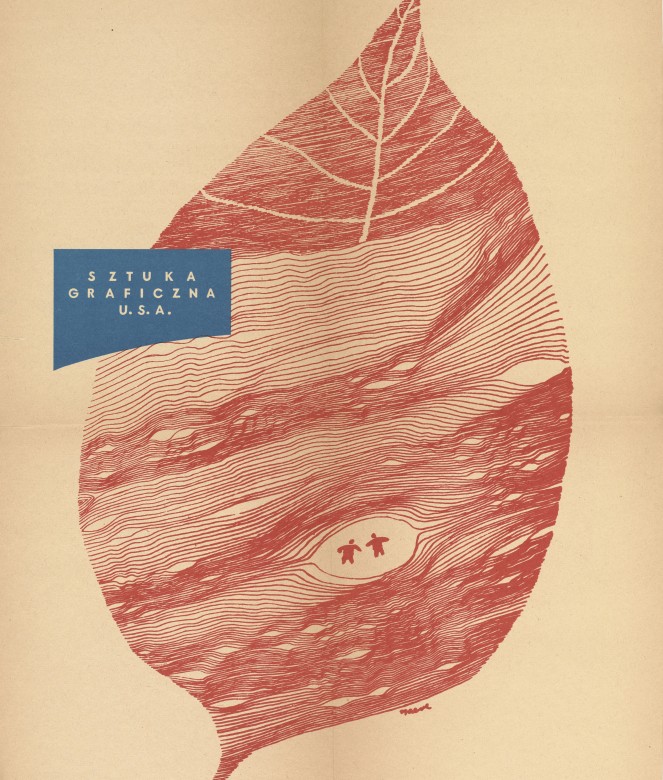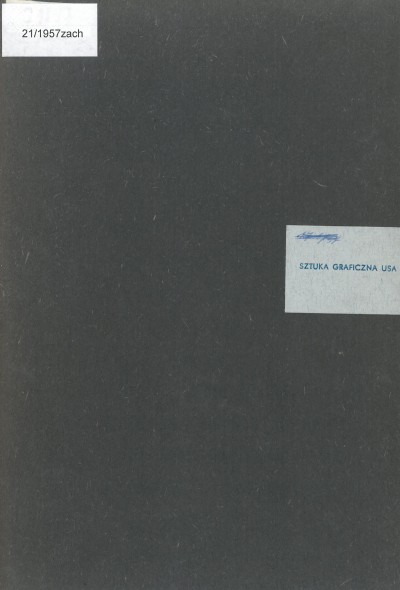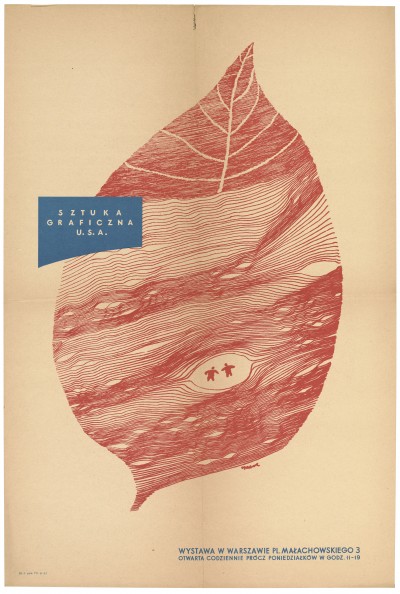American Graphic Art
09.12.1957 – 06.01.1958 American Graphic Art
Zachęta Central Bureau of Art Exhibitions (CBWA)
organiser: U.S. Embassy in Poland, Central Bureau of Art Exhibitions
substantive development of the exhibition: Doris Meltzer
poster design: Lowell Naeve
number of artists: 122
number of exhibits: 150
‘For the first time we have the opportunity to get more closely acquainted with drawings, prints and watercolours from the United States. Therefore, the exhibition in “Zachęta” crucially supplements our limited knowledge of the art of this country and provides us with the basis for making judgements, even if very fragmentary, as to its unique character,’ Ignacy Witz wrote in a review of the American Graphic Art exhibition, opened in the Central Bureau of Art Exhibitions (CBWA) in December 1957.[1]
The American display had been announced in the Polish press by the end of October 1957. For example, Trybuna Ludu gave the number of works (‘about 150’) and indicated three participants: ‘from among the American artists more familiar to their Polish colleagues, Mary Cassot [Cassat — GŚ], Hopper and Archipenko will have their works presented’.[2] In just a few reviews and articles it was emphasised that this first exhibition of engravings from the United States had been mounted thanks to the efforts of the US Embassy.[3] Doris Meltzer, director of the National Serigraph Society, gathered the exhibits and developed the event, which showed both a selection of works from American collections and a touring exhibition of watercolours, L’Aquarelle Contemporaine aux États-Unis (organised by the Cultural Section of the US Embassy and L’Action Française). The prints featured in the CBWA came from the Metropolitan Museum of Art, while the drawings came from, among others, the Fogg Art Museum, Rosenwald Collection, American Association of University Women and New York art galleries.[4]
Stressing the fact that the Polish public shaped its ideas about American culture mostly by reading American authors (Hemingway, Caldwell, Steinbeck, Faulkner), Ignacy Witz, in his review, enumerated some deficiencies regarding the list of the artists participating in the exhibition at the CBWA: ‘Lacking are those whose social bent is known to us, so first of all Ben Shahn, Gropper, an artist famous in our country, Charles White, Steinberg, the most outstanding innovative satirist and others, in particular artists enchanted by old American primitives. Somehow it happens that the artists I have just named appear in my mind as the most closely . . . bound up with American culture.’[5]
At the same time, in this most thorough and insightful review Witz notes that the American art presented at the CBWA in 1957 was created by people who had come to the United States from all over the world, thus ‘you feel here the radiation of dozens of different cultures brought by the artists from every nook and cranny of the world. Georgian demons, Parisian moods, small Eastern European ghettos, the passions and dramatic tensions of Spain, lyrical Slav unbridledness and the Central European search for synthesis — everything mixes here . . . In the exhibition halls of “Zachęta”, we also find a heroic period of a struggle for new art reflected in the drawings of Archipenko, a prominent Ukrainian sculptor. The first influences of impressionism can be noticed in the works of Mary Cassatt and Whistler, equally French as American . . . This melting pot conveys a definite but not fully crystallised image, the image of the incipient tradition which conditions any further progress in art.’[6]
Witz adds to the above acknowledgement of multiculturalism the remark that Zygmund Menkes (in the exhibition catalogue — Sigmund Menkes, a painter of Jewish origin, born in 1806 in Lwów, connected with the Ecole de Paris) ‘can be considered as an artist to a considerable extent Polish’, in spite of the fact that he ‘emigrated from Poland about a quarter of a century ago’[7] [Menkes left for the United States in 1935 — GŚ].
In an unsigned review published in Tygodnik Powszechny it was emphasised, in the same vein, that ‘more or less one third of the artists seen at the exhibition were born outside the US, usually in Europe’ and simultaneously ‘the most outstanding names’ of the display were repeated: ‘Archipenko, an excellent Ukrainian sculptor, and the classics of American art, Whistler and Mary Cassatt.’[8] In spite of their recognising the importance of the first exhibition of American art at the CBWA, critics noticed the absence of some artists (William Gropper as well as Jackson Pollock), ‘Saul Steinberg, a brilliant graphic artist popular in Poland (Romanian by origin, American by choice), is missing [at the exhibition]; there are not any works by one of the greatest American painters, Ben Shahn (born somewhere in the Vilnius Region); Jackson Pollock, Mark Tobey, de Kooning and Demuth are absent, too. The visitor will not find representatives of social satire either, such as William Gropper, famous in our country.’[9] It should be mentioned that the Polish public knew Gropper from, among others, the Exhibition of Works by Progressive Artists (CBWA, 6 February–6 March 1954). The postulate that ‘it would be nice . . . to see a display of American paintings, and even better , for example, a “one-man show” by Ben Shahn’ is also an interesting idea’.[10] The lack of works by this painter had already been observed in the reviews of the Exhibition of Works by Progressive Artists, organised by the Committee for Cultural Cooperation with Foreign Countries, which functioned as early as the period of Stalinism (1950–1956).[11]
It should be noted that the keen eye of the Sztandar Młodych reviewer spotted, at the exhibition in the CBWA, apart from the drawings of Mary Cassatt and Whistler, ‘an etching by Edward Hopper — a well-known representative of the realist movement’, ‘a drawing by Georgia O’Keffe [O’Keeffe — GŚ] and the presence of works by Morris Graves, a representative of the so called Northwest School’.[12]
The arguments about the ‘great absentees’ were undoubtedly inspired by the text O sztuce amerykańskiej [On American Art] by Bohdan Urbanowicz, published in the exhibition catalogue. It introduced the reader to the history of American art, including the artistic work of Pollock and Hopper, and mentions its points of contact with European art; the activity of Archipenko in the US after 1923 provides an example here. At the same time, Urbanowicz explains that, first of all, the exhibition at the CBWA was not a review of ‘the entirety of American art’; second, it keeps neither a chronological order nor one systematising artistic movements; third, it lacks some names, including ‘Kooning, Tobey and Pollock’.[13] The critics’ demand for the presence of Shahn probably resulted from Urbanowicz announcing in his essay that ‘realist and social works by Ben Shahn will be put on display’.[14] This discrepancy between the content of the essay written beforehand and the final form of the event in the CBWA was officially explained by the following annotation in the catalogue: ‘The transport conditions of the touring exhibition limited its dimensions and made it impossible to bring larger works recently created by American artists.’[15]
The exhibition occupied five rooms at Zachęta.[16] Witz criticised the way of showing the works: ‘The exhibition presents numerous interesting works and artists. Unfortunately, their viewing is impeded by an ill-considered arrangement, scattering pieces by one artist in various rooms and on different walls, which in advance renders it impossible to take in the works done by one hand and sense their atmosphere. The case of the overly mixed genres is much the same and leads to the blurring of the most crucial and enjoyable feature of this exhibition, that is, the diversity of coexisting tendencies. In a word, you have to order this chaos by yourself . . .’[17] The reviewer from Sztandar Młodych, on the other hand, adopted a more favourable attitude towards the form of work presentation, remarking, ‘Please note the interesting way of exhibiting graphics, a perfectly composed square room with a semi-circular black screen.’[18]
Petra Skarupsky
(ed. Gabriela Świtek)
Institute of Art History of the University of Warsaw
This compilation was prepared as part of the National Programme for the Development of Humanities of the Polish Minister of Science and Higher Education — research project The History of Exhibitions at Zachęta — Central Bureau of Art Exhibitions in 1949–1970 (no. 0086/NPRH3/H11/82/2016) conducted by the Institute of Art History of the University of Warsaw in collaboration with Zachęta — National Gallery of Art.
Bibliography
Catalogues:
- Sztuka graficzna USA, introduction: Bohdan Urbanowicz. Warsaw: Centralne Biuro Wystaw Artystycznych, 1957
- Rocznik CBWA 1957. Warsaw: Centralne Biuro Wystaw Artystycznych, [1958], pp. 22–23
Source texts:
- (b). ‘Po raz pierwszy Warszawa . . . ’. Stolica, no. 1, 1958
- Barbara. ‘Grafika USA w „Zachęcie”’. Sztandar Młodych, no. 302, 1957
- ‘Grafika amerykańska’. Tygodnik Powszechny, no. 5, 2 February 1958
- Grubert, H. ‘O paryskiej wieży Eiffla . . .’. Express Wieczorny, no. 255, 1957
- (l j). ‘Wystawa grafiki amerykańskiej’. Kurier Polski, no. 85, 1957
- Osęka, Andrzej. ‘Spotkanie ze sztuką USA’. Trybuna Ludu, no. 20, 1958
- Stopczyk, Stanisław K. ‘Młoda grafika amerykańska’. Kierunki, no. 4, 1958
- (b. a.). ‘Sztuka graficzna USA’. Zwierciadło, no. 1, 1958
- Witz, Ignacy. ‘Grafika amerykańska’. Życie Warszawy, no. 2, 1958
- (b. a.). ‘Wystawa rysunków i grafiki amerykańskiej’. Trybuna Ludu, no. 300, 30 October 1957
- z k. ‘Wystawa sztuki graficznej USA’. Trybuna Ludu, no. 341, 10 December 1957
Additional compilations (American graphic art):
- Acton, D. A Spectrum of Innovation: Color in American Printmaking 1890–1960. London, 1990
- Castleman, R. Prints of the Twentieth Century: A History. New York, 1988
- Shadwell, W. American Print Making: First 150 Years. Washington, DC, 1969
- Smith, J. T., Murphy, K. M. Pressed in Time: American Prints 1905–1950. San Marino, CA, 2008
- Twentieth-Century American Drawing: Three Avant-Garde Generations, exh. cat. New York: Solomon R. Guggenheim Museum, 1976
Artists
Drawing: Aleksandr Archipenko, Dorr Bothwell, Byron Browne, Charles Burchfield, Kenneth Callahan, Rhys Caparn, Mary Cassatt, Edward Chávez, Lily Cushing, Fred Farr, Madeleine Gekiere, Edward Giobbi, Morris Graves, Marsden Hartley, John Hultberg, Angelo Ippolito, Mitchell Jamieson, Paul Jenkins, Walter Kamys, Morris Kantor, Robert Leland Kiley, Gaston Lachaise, Robert Laurent, Vincent Longo, Ezio Martinelli, George Morrison, Lowell Naeve, Georgia O’Keeffe, Robert Andrew Parker, Tom V. Schmitt, Charles Seliger, Edward John Stevens, Joachim H. Themal, Jean (Jones) Watts, James Abbott McNeill Whistler.
Graphic arts: Irving Amen, Leonard Baskin, John Bernhardt, Dorr Bothwell, Fiske Boyd, Howard Bradford, Louis Bunce, Mary Cassatt, Minna Citron, Glenn O. Coleman, Warrington Colescott, siostra Mary Corita [Sister Mary Corita Kent], Ralston Crawford, Zulema Damianovich, Arthur B.[owen] Davies, Worden Day, Richard A. Florsheim, Antonio Frasconi, Jan Gelb, Gorden Gilkey, Philip Hicken, Sheila Boyd Hoermann, Winslow Homer, Edward Hopper, Hans Jelinek, Robert Leland Kiley, Edward Landon, Boris Margo, Joseph Margulies, Henry Mark, Robert Marx, Sigmund Menkes, Seong Moy, Thomas Nast, Frederick O’Hara, Joseph Pennell, Jack Perlmutter, Gabor Peterdi, Leonard Pytlak, Bernard Reder, Hulda D. Robbins, Anne Ryan, Louis Schanker, Karl Schrag, Kurt Seligmann, Nahum Tschacbasov, Janet Turner, Mary Van Blarcom, Sylvia Wald, Emil Weddige.
Watercolours: William Baziotes, Morris Blackburn, William Boughton, Byron Browne, Gunvor Bull-Teilman, Charles Burchfield, Gene Charlton, George Constant, Fred Conway, Lucille Corcos, Dorothy Dehner, Lamar Dodd, Ethel Edwards, Jimmy Ernst, Betty Esman, Ilse Getz, Xavier Gonzales, Frank Govan, Morris Graves, Balcomb Greene, Siv Holme, Martha Visser’t Hooft, Florence Kawa, Dong Kingman, Michael Lekakis, Douglas Lockwood, Einar Lunden, Reginald Marsh, Ezio Martinelli, Hans Moller, Isaac Lane Muse, Arthur Osver, Gabor Peterdi, Phillip Pieck, Sibley Smith, Irwin Touster, Sylvia Wald.
[1] Ignacy Witz, ‘Grafika amerykańska’, Życie Warszawy, no. 2, 2 January 1958.
[2] ‘Wystawa rysunków i grafiki amerykańskiej’, Trybuna Ludu, no. 300, 30 October 1957.
[3] z k, ‘Wystawa sztuki graficznej USA’, Trybuna Ludu, no. 341, 10 December 1957.
[4] Cf. Sztuka graficzna USA, exh. cat., Centralne Biuro Wystaw Artystycznych, Warsaw, 1957, n.pag. The works were borrowed from: The American Association of University Women, Grace Borgenicht Gallery, Julius Carlebach Gallery, Contemporary Arts, Inc., Fogg Art Museum, Grand Central Moderns, Heller Gallery, Martha Jackson Gallery, Kootz Gallery, Meltzer Gallery, Metropolitan Museum of Art, Midtown Galleries, Milch Galleries, National Gallery of Art (Rosenwald Collection), Frank K.M. Rehn Gallery, Roko Gallery, Bertha Schaefer Gallery, Tom V. Schmitt, Maynard Walker Gallery, Weyhe Gallery, Willard Gallery, and Zabriskie Gallery.
[5] Witz.
[6] Ibid.
[7] Ibid.
[8] ‘Grafika amerykańska’, Tygodnik Powszechny, no. 5, 2 February 1958.
[9] Ibid.
[10] Ibid.
[11] For more on the activity of the Committee for Cultural Cooperation with Foreign Countries see Karolina Zychowicz, The ‘Exhibition-Organising Activity of the Committee for Cultural Cooperation with Foreign Countries (1950–1956) Based on the Example of Selected Exhibitions at the Zachęta Central Bureau of Art Exhibitions’, trans. Klaudyna Michałowicz, Ikonotheka, no. 26, 2016, pp. 63–94.
[12] Barbara, ‘Grafika USA w „Zachęcie”’, Sztandar Młodych, no. 302, 1957.
[13] Bohdan Urbanowicz, ‘O sztuce amerykańskiej’, in Sztuka graficzna USA, exh. cat., Warsaw: Centralne Biuro Wystaw Artystycznych, 1957, n.pag.
[14] Ibid.
[15] Sztuka graficzna USA, n.pag.
[16] z k.
[17] Witz.
[18] Barbara.
American Graphic Art
09.12.1957 – 06.01.1958
Zachęta Central Bureau of Art Exhibitions (CBWA)
pl. Małachowskiego 3, 00-916 Warsaw
See on the map


